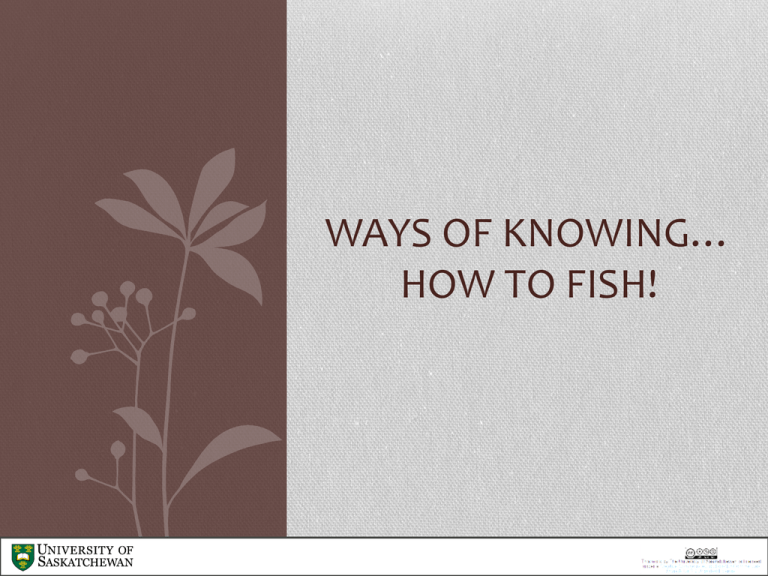WAYS OF KNOWING… HOW TO FISH!
advertisement

WAYS OF KNOWING… HOW TO FISH! Western Sport Fishing • Fishing for sport has brought many changes to natural lake ecology, mostly for the sake of fun rather than nutrition • Today ecologists assess and manage these changes using the ‘Bag & Tag’ method to determine the health of fish populations Fish Tagging Gun Tagged fish, and hydro-acoustic tags The best sport is ‘Catch & Release’ – this lake Sturgeon will go back in the lake, and can live for upwards of 100 years! Traditional Fishermen in Northern Saskatchewan were aware that lakes needed to be fished in a sustainable way – their practices included natural catch limits The First Nations peoples “observed the lakes and the numbers of fish that they caught. When numbers went down they would move to another lake, or location on the lake, so that stock would not be reduced. In this way, fishing practices were ecologically sustainable.” Fish populations provided a signal to the people to live in balance with the land, and to respect the health of the waters Some Northern Dene stories relate messages about ecological balance given by the presence of gigantic fish appearing: … Doug Lamalice said the legend was passed onto him from his grandmother before she died, and has been told by countless elders within the community. Elders described the creature as large, black, and shiny, looking not fully alive, but not completely dead. Lamalice said the large fish appeared only for a few days and, as the water rose, people gathered their gear and moved inland for a few days until they received word the fish had disappeared. “After she told me the story, she always said, ‘These things really happened,’” said Lamalice. “I know it’s hard as a grown person to believe the things they hear in these stories, but this is story that is part of our culture. I’ve heard a lot of legends and they’re hard to fathom, but when something like this happens it concludes my thinking that it’s untrue.” It’s said the fish first appeared at Fish Point on Hay River. Lamalice noted that close by there are sections of Great Slave Lake that are nearly three miles deep.Elders said the fish appeared "long ago, back when the world was new.”It wasn’t only a terrifying apparition, but Lamalice said his ancestors took it as a warning. “For them it was a sign of things to come and things that could happen,” he said. “They did things more carefully after that. They said they learned to treat the land with respect and not take what they didn’t need.” Full News Article at: http://www.nnsl.com/frames/newspapers/2012-07/jul2_12fish.html Imagine if you met a giant Fish! Use some paper in your classroom and cover an area on the floor that is THREE METERS long, and up to ONE METER wide near the middle This is the space that a 150 year old, 280 kg Lake Sturgeon (they have been caught in Saskatchewan) would take up in your classroom! Imagine if you met a giant Fish! Most River and Lake Sturgeon are much smaller, and lifespans of 30 to 80 years are more common… but 150 year old fish have been caught and recorded in our province. What kinds of changes to Saskatchewan’s Lakes and Rivers do you think your giant sturgeon has experienced? When fish are caught as a source of food, Elders remind us that… Fish meat – delicious for people, and kept dried as dog food in many communities Fish skins – traditionally made into waterproof bags Fish oils – act as grease, lamp oil, and lubricants EVEN Fish scales – can be boiled to make glue, or used as decorative elements. Dyed fish scale art is applied to birch baskets and fishing bags, and used to make jewelry in some Northern communities. To help you understand more about Saskatchewan’s fish, • practice the ‘Bag & Tag’ method with marbles, • or try your hand at making art with fish scales!




